(完整word版)可数与不可数名词
高中英语常考不可数名词word版本

wealth
财富,富裕
friendship
友谊
energy
精力
homework
家庭作业
knowledge
知识
nature
自然
luck
运气
health
健康
technology
技能
courage
勇气
help
帮助
hope
希望
food
食物
wood
木材
scenery
风景
jewelry
珠宝
poetry
诗歌
evidence
fun
开心、快乐的事
What fun it is to do sth.!
furniture
家具
a set of furniture
news/information
/word
消息,新闻
WorБайду номын сангаас came that he won the first prize in the match.
baggage/luggage
行李
a piece of baggage/luggage
progress
进步
make great/rapid/some/no progress in sth.
practice
练习
Practice makes perfect.
work
工作
weather
天气
applause
掌声
a burst of applause一阵掌声
5
我们长期呆在校园里,没有工作收入一直都是靠父母生活,在资金方面会表现的比较棘手。不过,对我们的小店来说还好,因为我们不需要太多的投资。
(完整word版)单词属性表
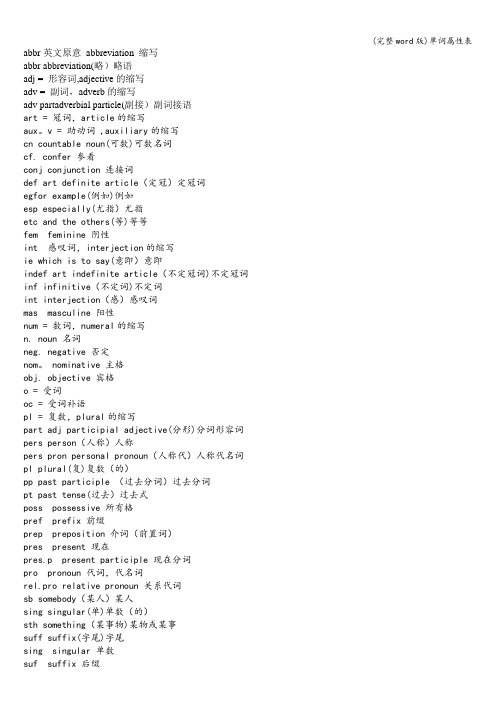
abbr英文原意abbreviation 缩写abbr abbreviation(略)略语adj = 形容词,adjective的缩写adv = 副词,adverb的缩写adv partadverbial particle(副接)副词接语art = 冠词,article的缩写aux。
v = 助动词 ,auxiliary的缩写cn countable noun(可数)可数名词cf. confer 参看conj conjunction 连接词def art definite article(定冠)定冠词egfor example(例如)例如esp especially(尤指)尤指etc and the others(等)等等fem feminine 阴性int 感叹词,interjection的缩写ie which is to say(意即)意即indef art indefinite article(不定冠词)不定冠词inf infinitive(不定词)不定词int interjection(感)感叹词mas masculine 阳性num = 数词,numeral的缩写n. noun 名词neg. negative 否定nom。
nominative 主格obj. objective 宾格o = 受词oc = 受词补语pl = 复数,plural的缩写part adj participial adjective(分形)分词形容词pers person(人称)人称pers pron personal pronoun(人称代)人称代名词pl plural(复)复数(的)pp past participle (过去分词)过去分词pt past tense(过去)过去式poss possessive 所有格pref prefix 前缀prep preposition 介词(前置词)pres present 现在pres.p present participle 现在分词pro pronoun 代词,代名词rel.pro relative pronoun 关系代词sb somebody(某人)某人sing singular(单)单数(的)sth something(某事物)某物或某事suff suffix(字尾)字尾sing singular 单数suf suffix 后缀s = 主词sc = 主词补语u = 不可数名词,uncountable noun的缩写US America(n)(美)美国(的)VP Verb Pattern(动型)动词类型vt verb transitive (及物动词)及物动词v verb 动词v aux。
(完整word版)可数名词与不可数名词

可数名词与不可数名词
可数名词
可数名词是指能以数目来计算,可以分成个体的人或东西;因此它有复数形式,当它的复数形式在句子中作主语时,句子的谓语也应用复数形式。
名词根据其可数性可分为可数名词(Countable Noun)和不可数名词(Uncountable Noun)。
可数名词即指可以分为个体,
且可直接用数目进行计数的名词,如课桌、风筝、女孩、房间、学校等。
名词可缩写为[N].可数名词可缩写为【cn】,不可数名词可缩写为【un】
例如:Little children are fond of stories .小孩子们喜欢听故事。
Movie stars are usually popular with young people. 影星们常受到年轻人的欢迎。
可数名词的单数形式前常用不定冠词 a / an , 当它的单数形
式在句子中作主语时,句子的谓语也应用单数形式。
例如:
There is an orange on the table .桌上有只桔子。
A university is a higher educational institution .大学是高等教育机构。
可数名词的形式。
word可数还是不可数
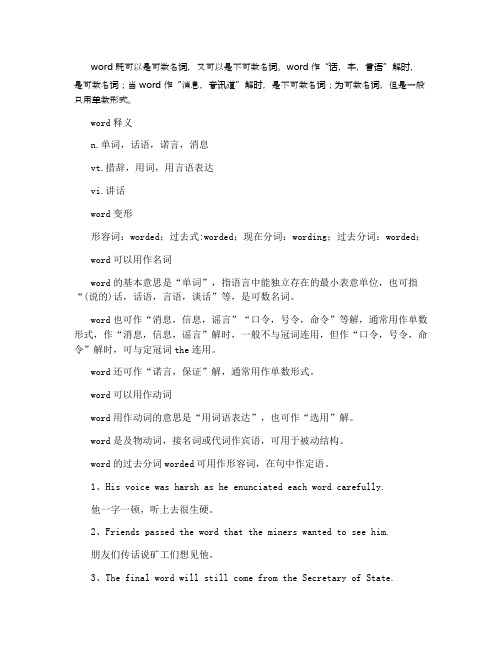
word既可以是可数名词,又可以是不可数名词。
word作“话,字,言语”解时,是可数名词;当word作“消息,音讯道”解时,是不可数名词;为可数名词,但是一般只用单数形式。
word释义
n.单词,话语,诺言,消息
vt.措辞,用词,用言语表达
vi.讲话
word变形
形容词:worded;过去式:worded;现在分词:wording;过去分词:worded;
word可以用作名词
word的基本意思是“单词”,指语言中能独立存在的最小表意单位,也可指“(说的)话,话语,言语,谈话”等,是可数名词。
word也可作“消息,信息,谣言”“口令,号令,命令”等解,通常用作单数形式,作“消息,信息,谣言”解时,一般不与冠词连用,但作“口令,号令,命令”解时,可与定冠词the连用。
word还可作“诺言,保证”解,通常用作单数形式。
word可以用作动词
word用作动词的意思是“用词语表达”,也可作“选用”解。
word是及物动词,接名词或代词作宾语,可用于被动结构。
word的过去分词worded可用作形容词,在句中作定语。
1、His voice was harsh as he enunciated each word carefully.
他一字一顿,听上去很生硬。
2、Friends passed the word that the miners wanted to see him.
朋友们传话说矿工们想见他。
3、The final word will still come from the Secretary of State.
最后仍然要由国务卿来定夺。
(完整word版)全初中必背英语语法知识汇总

全!初中必背英语语法知识汇总语法是中考英语考试必考点。
语法知识掌握得好,将大大加快英语学习的进程。
本文归纳了词法和八种基本时态,希望对广大初中学子有所帮助。
词法名词(1)名词的可数与不可数可数名词指表示的人或事物可以用数来计量,它有单数与复数两种形式。
不可数名词指所表示的事物不能用数来计量。
不可数名词前一般不能用冠词a、an来表示数量,要表示“一个……”这一概念,须加a piece of这一类短语。
(2)可数名词复数的规则变化A.一般情况下加-sB.以s, x, ch, sh, 结尾的加-esC.以辅音字母加y结尾的改y为i再加-esD.以f,fe结尾,去掉f或fe,变v再加-es(3)名词的所有格①. 单数名词词尾加’s,复数名词词尾若没有s,也要加’s如:the worker's bike,the Children’s ball②.表示几个人共有一样东西,只需在最后一个人的名字后加’s若表示各自所有,则需在各个名字后’s如:This is Lucy and Licy’s room.These are Kate's and jack’s rooms.③. 如果是通过在词尾加—s构成的复数形式的名词,只加’。
如:the students’books,the girls’blouses代词(1)人称代词第一人称单数I me my mine myself复数we us our ours ourselves第二人称单数you you your yours yourself复数you you your yours yourselves第三人称单数 he him his his himselfshe her her hers herselfit it its its itself复数they them their theirs themselves(2)物主代词物主代词的用法:形容词性物主代词后面一定要跟上一个名词;名词性物主代词可作主语、表语、宾语。
可数名词与不可数名词
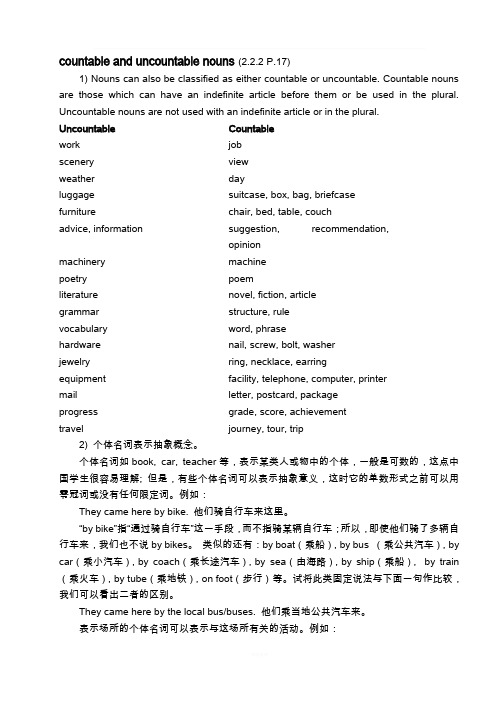
countable and uncountable nouns(2.2.2 P.17)1) Nouns can also be classified as either countable or uncountable. Countable nouns are those which can have an indefinite article before them or be used in the plural. Uncountable nouns are not used with an indefinite article or in the plural.Uncountable Countablework jobscenery viewweather dayluggage suitcase, box, bag, briefcasefurniture chair, bed, table, couchadvice, information suggestion, recommendation,opinionmachinery machinepoetry poemliterature novel, fiction, articlegrammar structure, rulevocabulary word, phrasehardware nail, screw, bolt, washerjewelry ring, necklace, earringequipment facility, telephone, computer, printermail letter, postcard, packageprogress grade, score, achievementtravel journey, tour, trip2) 个体名词表示抽象概念。
个体名词如book, car, teacher等,表示某类人或物中的个体,一般是可数的,这点中国学生很容易理解; 但是,有些个体名词可以表示抽象意义,这时它的单数形式之前可以用零冠词或没有任何限定词。
(完整版)既可以作可数名词又可以作不可数名词的单词

既可以作可数名词又可以作不可数名词的单词具体是可数还是不可数要在具体语言环境中体现,你可以只记一方面,记住可数的,其他方面大多为不可数了.在牛津词典的标注中,一种含义的注释前面都有[C,U],所以,此题不能完全绝对的回答1.interest作名词既可做可数名词也可以做不可数名词interest作为“兴趣”讲时用作不可数名词,但可以加不定冠词.interest作“爱好;引起兴趣的地方”讲时为可数名词.interest 作“利害(关系);权益;股份”讲时,为可数名词2.glass——玻璃——玻璃杯paper——纸——报纸、文件tin——锡——罐头copper ——铜——铜币iron——铁——熨斗youth——青春——青年人beauty——美——美人necessity——必要性——必需品3.salad,ice cream, cabbage,onion, wine一颗白菜,一份沙拉,一盒冰激凌,一颗洋葱,这就可数.当作吃的东西泛指的时候,比如洋葱全都切成丝看不出来几颗的时候,就不可数.说明一下:当一个不可数名词被用於分类的情况时,它可以被当做可数名词. 因此,以wine 为例子, wine 通常是个不可数名词("I'd love wine with dinner."),即使你喝了一杯以上的酒,你仍然是喝wine ,而不是wines . 但当我们在做酒的分类时,这名词就变成了可数的:"There are many fine Canadian wines.". 甚至water这个字在某些情况下也可以变成可数的:"the waters of the Pacific Ocean are noticeably colder this year.". 有时一个名词可以是可数或是不可数,而它们的意思几乎完全相同:Chilean wine is superb. Chilean wine is superb.Chilean wines are superb. Chilean wines are superb.一般来说,个体名词和集体名词是可以计数的,所以称之为可数名词,有单、复数形式.例如:a city(一个城市)——two cities(两个城市),a bird(一只鸟)——five birds(五只鸟).其中复数的形式变化就不说了,你应该知道.有规则的变化形式,也有不规则的,不规则的需要你自己平时多记.物质名词和抽象名词一般是不可计数的,所以称之为不可数名词,它们通常只有单数形式.但在具体情况下也可以用作可数名词.snow(雪)snows(积雪)water(水)waters(海/湖水)cloth(布)clothes(衣服)paper(纸)papers(报纸/文件/试卷)time(时间)times(时代/次数/倍)custom(习惯)customs(海关)Fish 可数与不可数的问题1. 鱼肉因为是物质名次,不可数I will have fish for dinner.2.表示鱼的数量,单复数同形There are some fish in the river.3. 表示鱼的总类可数,因为是个体名词Many fishes are in the sea.。
可数与不可数名词(最新整理)
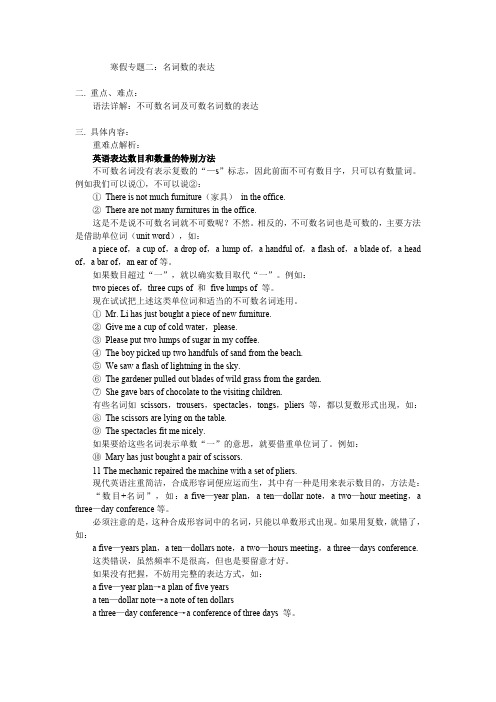
寒假专题二:名词数的表达二. 重点、难点:语法详解:不可数名词及可数名词数的表达三. 具体内容:重难点解析:英语表达数目和数量的特别方法不可数名词没有表示复数的“—s”标志,因此前面不可有数目字,只可以有数量词。
例如我们可以说①,不可以说②: ①There is not much furniture(家具)in the office. ②There are not many furnitures in the office. 这是不是说不可数名词就不可数呢?不然。
相反的,不可数名词也是可数的,主要方法是借助单位词(unit word),如: a piece of,a cup of,a drop of,a lump of,a handful of,a flash of,a blade of,a head of,a bar of,an ear of等。
如果数目超过“一”,就以确实数目取代“一”。
例如: two pieces of,three cups of 和five lumps of 等。
现在试试把上述这类单位词和适当的不可数名词连用。
①Mr. Li has just bought a piece of new furniture. ②Give me a cup of cold water,please. ③Please put two lumps of sugar in my coffee. ④The boy picked up two handfuls of sand from the beach. ⑤We saw a flash of lightning in the sky. ⑥The gardener pulled out blades of wild grass from the garden. ⑦She gave bars of chocolate to the visiting children. 有些名词如scissors,trousers,spectacles,tongs,pliers 等,都以复数形式出现,如: ⑧The scissors are lying on the table. ⑨The spectacles fit me nicely. 如果要给这些名词表示单数“一”的意思,就要借重单位词了。
(完整版)英语语法名词练习题(可编辑修改word版)
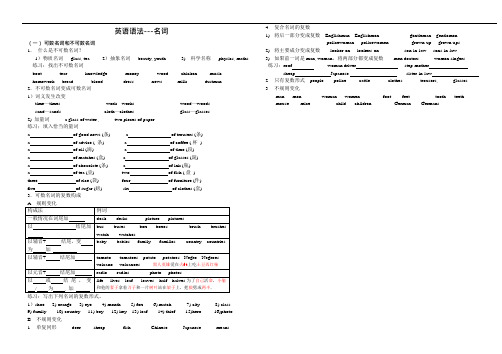
(一)可数名词和不可数名词1.什么是不可数名词?英语语法---名词 4. 复合名词的复数1)将后一部分变成复数Englishman---Englishmen gentleman---gentlemenpolicewoman----policewomen grown-up --- g rown-ups2)将主要成分变成复数looker-on----lookers-on son-in-law ---- s ons-in-law1)物质名词glass, tea 2)抽象名词beauty, youth 3) 科学名称physics, maths 3) 如果前一词是man, woman,将两部分都变成复数men doctors women singers 练习:找出不可数名词练习:roof woman driver step-motherboot tear knowledge money wood chicken music sheep Japanese sister-in-lawhomework bread blood dress news milk dustman 2.不可数名词变成可数名词1)词义发生改变time—times work---works wood—woodssand—sands cloth—clothes glass—glasses2) 加量词 a glass of water , two pieces of paper练习;填入恰当的量词a of good news (条) a of trousers (条)a of advice ( 条) a of coffee ( 杯)a of oil (滴) a of time (段)a of matches (盒) a of glasses (副)a of chocolate (条) a of ink (瓶)a of tea (壶) two of fish ( 盘)three of rice (袋) four of furniture (件)five of sugar (磅) six of clothes (套)3.可数名词的复数构成练习:写出下列名词的复数形式。
(完整word版)英语语法汇总

英语语法汇总第一章名词一、名词的分类:名词就其词汇意义可分为专有名词和普通名词。
普通名词又可分为可数名词和不可数名词。
专有名词:Beijing Smith the United Nations个体名词:man, expert, factory可数名词集合名词:audience(观众),class, family普通名词:物质名词:water, coal, rice不可数名词抽象名词:surprise, honour, help二、可数名词的复数形式1.一般情况,直接加-s。
port(港口)→ports;technique(技术)—techniques2.以s, x, ch, sh结尾发[s]、[∫]、[t∫]、[dЗ]音的词,加—esbus—buses, box—boxes, bush—bushesbranch—branches,stomach—stomachs(stomach词尾发k,故复数直接加-s)3.辅音字母+ y,变y为i,加-es university—universitiesy前为元音字母,直接加-s boy—boys4.以O结尾加-es hero—heroesO前为元音字母,及部分外来词直接加-szoo—zoos radio—radio piano—pianos photo—photos5.以f或fe结尾,变f或fe为v,再加-es leaf—leaves wife—wives※以下f结尾单词直接加-s belief—beliefs(信念)roof—roofs(屋顶)proof—proofs(证据)safe—safes(保险柜)chief—chiefs(首领)gulf—gulfs(海湾)6.不规则名词man—men, woman—women, foot—feet, tooth—teeth,goose—geese, mouse—mice, child—children, ox—oxen注1:有些可数名词的单复数相同,要根据上下文的意义来确定其单数还是复数,例如:sheep 羊fish 鱼deer 鹿means手段,方法works工厂,作品series系列注2:在些可数名词,只有单数形式,但表示复数意义。
可数名词与不可数名词
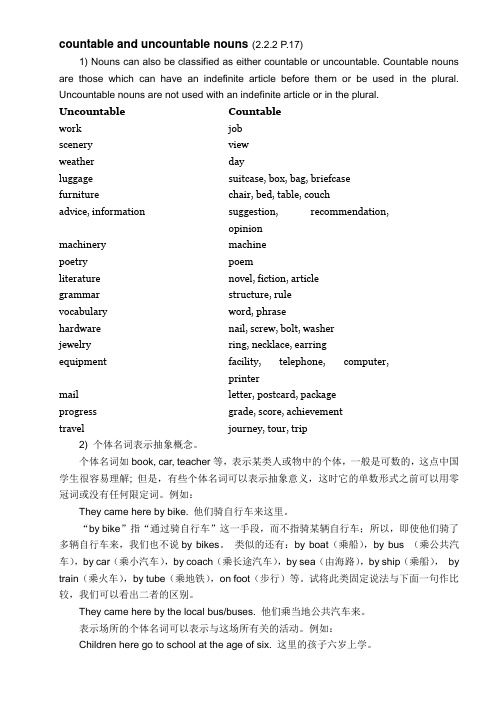
countable and uncountable nouns(2.2.2 P.17)1) Nouns can also be classified as either countable or uncountable. Countable nouns are those which can have an indefinite article before them or be used in the plural. Uncountable nouns are not used with an indefinite article or in the plural.Uncountable Countablework jobscenery viewweather dayluggage suitcase, box, bag, briefcasefurniture chair, bed, table, couchadvice, information suggestion, recommendation,opinionmachinery machinepoetry poemliterature novel, fiction, articlegrammar structure, rulevocabulary word, phrasehardware nail, screw, bolt, washerjewelry ring, necklace, earringequipment facility, telephone, computer,printermail letter, postcard, packageprogress grade, score, achievementtravel journey, tour, trip2) 个体名词表示抽象概念。
个体名词如book, car, teacher等,表示某类人或物中的个体,一般是可数的,这点中国学生很容易理解; 但是,有些个体名词可以表示抽象意义,这时它的单数形式之前可以用零冠词或没有任何限定词。
可数名词和不可数名词PPT课件

考点一 可数名词
规则变化: 5.以o结尾的名词有4个词加es,其他的都加s, 请看加es的四个单
词的口诀: 加es:黑人 (Negro) 喜欢吃土豆 (potato);英雄 (hero) 喜欢
吃西红柿 (tomato) 6.以f或fe结尾的名词,通常先变f或fe为v再加es。可用以下口诀来
SUCCESS
2019/6/25
26
考点链接
C( )Mickey Mouse is one of the most famous ________ in
American ________.
A.symbol; culture C.symbols; culture
B.symbol; cultures D.symbols; cultures
解析:C 考查名词单复数。固定用法“one of the+最高级+可数名词复数” 决定famous后面的名词要用复数;culture 是不可数名词,所以答案是C。
答案:C
考点三 名词所有格
名词所有格用来表示名词和名词之间的所属关系。
1.有生命的名词的所有格
(1)一般名词(不以s结尾)的所有格是在词尾加“'s”。如:
sisters。 但如果由man, woman作前置定语构成的复合名词变复数时,则man或woman与后面的名词都 要变复数。如:two men teachers, some women doctors。 注意:(1)有些名词的单复数形式的意义不同。如:
two fish 两条鱼 two fishes 两类鱼 some people 一些人 some peoples 一些民族 (2)有些名词形式上是以s结尾,但意义上是单数,一般看作单数名词。如: news, maths, physics, politics, the United States等。
(完整word版)英语语法专业术语整理

英语语法专业术语本次听写要求:挑选部分英语术语打在PPT上,学生按序号写出相应中文术语.(一)词类part of speech实词notional word ['nəuʃənəl]虚词structural word/ form word (e.g。
article preposition conjunction interjection)派生词derivative [di’rivətiv, də’rivətiv]复合词compound ['kɔmpaund,kɔm’pau nd]词性part of speech名词noun专有名词proper noun普通名词common noun可数名词countable noun不可数名词uncountable noun单数形式singular form复数形式plural form [’pluərəl, 'plurəl]抽象名词abstract noun [æb’strækt,’æbstrækt]具体名词concrete noun [’kɔnkri:t]物质名词material noun集体名词collective noun个体名词individual noun动词verb主动词main verb及物动词transitive verb ['trænsitiv,’trænsətiv]不及物动词intransitive verb [in’trænsitiv,in'trænsətiv]系动词link verb助动词auxiliary verb [ɔ:g’ziljəri]情态动词modal verb规则动词regular verb不规则动词irregular verb短语动词phrasal verb ['freizl, ’freizəl]限定动词finite verb ['fainait]非限定动词infinite verb ['infinit, 'infənit]使役动词causative verb [’kɔ:zətiv]感官动词verb of senses动态动词event verb静态动词state verb形容词adjective比较等级degrees of comparison☆原级positive degree☆比较级comparative degree☆最高级superlative degree副词adverb方式副词adverb of manner程度副词adverb of degree时间副词adverb of time地点副词adverb of place修饰性副词adjunct连接性副词conjunct疑问副词interrogative adverb [.intə'rɔgətiv]关系副词relative adverb代词pronoun ['prəunaun]人称代词personal pronoun物主代词possessive pronoun [pə'zesiv]反身代词reflexive pronoun [ri'fleksiv]相互代词reciprocal pronoun [ri'siprəkəl]指示代词demonstrative pronoun [di'mɔnstrətiv]疑问代词interrogative pronoun [.intə'rɔgətiv]关系代词relative pronoun不定代词indefinite pronoun [in'definit, in'defənit]名词性物主代词nominal possessive pronoun形容词性物主代词adjectival possessive pronoun [.ædʒik'taivəl]冠词article定冠词definite article [’definit, 'defənit]不定冠词indefinite article介词preposition [prepə'ziʃən]连词conjunction [kən'dʒʌŋkʃən]感叹词exclamation [。
英语名词知识点总结
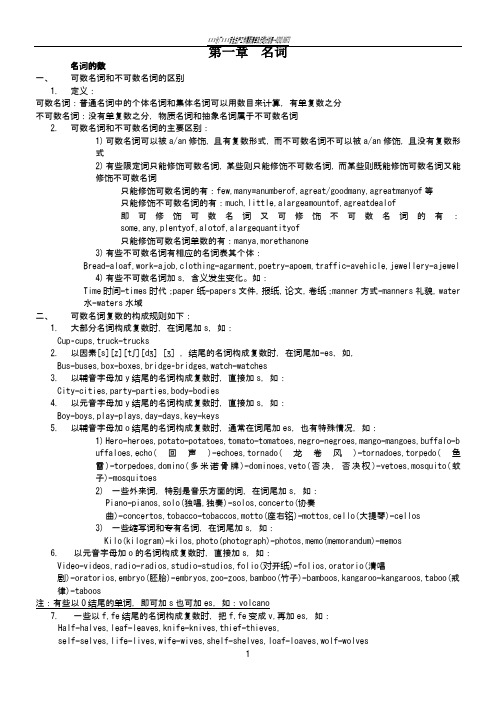
×××分厂×××安全生产工作履职清单及行动计划表--0202)89673第一章名词名词的数一、可数名词和不可数名词的区别1.定义:可数名词:普通名词中的个体名词和集体名词可以用数目来计算,有单复数之分不可数名词:没有单复数之分,物质名词和抽象名词属于不可数名词2.可数名词和不可数名词的主要区别:1)可数名词可以被a/an修饰,且有复数形式,而不可数名词不可以被a/an修饰,且没有复数形式2)有些限定词只能修饰可数名词,某些则只能修饰不可数名词,而某些则既能修饰可数名词又能修饰不可数名词只能修饰可数名词的有:few,many=anumberof,agreat/goodmany,agreatmanyof等只能修饰不可数名词的有:much,little,alargeamountof,agreatdealof即可修饰可数名词又可修饰不可数名词的有:some,any,plentyof,alotof,alargequantityof只能修饰可数名词单数的有:manya,morethanone3)有些不可数名词有相应的名词表其个体:Bread-aloaf,work-ajob,clothing-agarment,poetry-apoem,traffic-avehicle,jewellery-ajewel4)有些不可数名词加s,含义发生变化。
如:Time时间-times时代;paper纸-papers文件,报纸,论文,卷纸;manner方式-manners礼貌,water水-waters水域二、可数名词复数的构成规则如下:1.大部分名词构成复数时,在词尾加s,如:Cup–cups,truck-trucks2.以因素[s][z][tʃ][dʒ] [ʒ] ,结尾的名词构成复数时,在词尾加-es,如,Bus-buses,box-boxes,bridge–bridges,watch-watches3.以辅音字母加y结尾的名词构成复数时,直接加s,如:City-cities,party-parties,body-bodies4.以元音字母加y结尾的名词构成复数时,直接加s,如:Boy-boys,play-plays,day-days,key-keys5.以辅音字母加o结尾的名词构成复数时,通常在词尾加es,也有特殊情况,如:1)Hero-heroes,potato-potatoes,tomato-tomatoes,negro-negroes,mango-mangoes,buffalo-buffaloes,echo(回声)-echoes,tornado(龙卷风)-tornadoes,torpedo(鱼雷)-torpedoes,domino(多米诺骨牌)-dominoes,veto(否决,否决权)-vetoes,mosquito(蚊子)-mosquitoes2)一些外来词,特别是音乐方面的词,在词尾加s,如:Piano-pianos,solo(独唱,独奏)-solos,concerto(协奏曲)-concertos,tobacco-tobaccos,motto(座右铭)-mottos,cello(大提琴)-cellos3)一些缩写词和专有名词,在词尾加s,如:Kilo(kilogram)-kilos,photo(photograph)-photos,memo(memorandum)-memos6.以元音字母加o的名词构成复数时,直接加s,如:Video-videos,radio-radios,studio-studios,folio(对开纸)-folios,oratorio(清唱剧)-oratorios,embryo(胚胎)-embryos,zoo-zoos,bamboo(竹子)-bamboos,kangaroo-kangaroos,taboo(戒律)-taboos注:有些以O结尾的单词,即可加s也可加es,如:volcano7.一些以f,fe结尾的名词构成复数时,把f,fe变成v,再加es,如:Half-halves,leaf-leaves,knife-knives,thief-thieves,self-selves,life-lives,wife-wives,shelf-shelves,loaf-loaves,wolf-wolves口诀:为了自己活命,小偷和他的妻子手里拿着刀子和一片树叶站在架子上,把狼劈成了两半8.一些以f,fe结尾的名词构成复数时,直接加s,如:Gulf(鸿沟)-gulfs,serf(农奴)-serfs,belief-beliefs,chief(酋长)-chiefs,cliff(悬崖)-cliffs,proof-proofs,roof-roofs口诀:海湾农奴信酋长,悬崖证据上房顶注:以上两种情况均可的Wharf(码头),dwarf(侏儒),scarf(围巾),handkerchief(手绢),9.名词变复数不规则变化大体有以下变化1)单复数形不同,如Man–men,woman-women,foot-feet,tooth-teeth,mouse-mice,child-children,emphasis(强调)-emphases注:以man构成的合成词,是man变成men如:Englishman-Englishmen,Frenchman-Frenchmen,dustman-dustmen但German-Gemans,human-humans因为他们不是合成词2)单复数词形相同,如Deer,sheep,fish,works,(工厂)means(方式、途径),Chinese,Japanese,Swiss,bellows(风箱),series,crossroad,horsepower及由汉语拼音拼出的计量单位,如:yuan,li,jin,英语中原有的计量单位不在此列,如:dollar-dollars,pound-pounds,metre-metres除上述情况外,关于名词数的问题还应注意以下几个方面有些名词只有复数形式,一般不直接受数词或a(an)修饰,如果要表示数量用相应的起量词作用的名词。
(完整word版)英语词性的分类及用法

英语词性的分类及用法一、词性的分类词类又叫词性,英语单词根据其在句子中的功用,可以分成十个大类。
1 名词 noun n. student 学生2 代词 pronoun pron。
you 你3 形容词 adjective adj。
happy 高兴的4 副词 adverb adv. quickly 迅速地5 动词 verb v。
cut 砍、割6 数词 numeral num。
three 三7 冠词 article art。
a 一个8 介词 preposition prep. at 在。
..9 连词 conjunction conj。
and 和10 感叹词 interjection interj. oh 哦前六类叫实词,后四类叫虚词。
二、名词名词概论名词复数的规则变化名词的格在英语中有些名词可以加"’s"来表示所有关系,带这种词尾的名词形式称为该名词的所有格,如:a teacher's book。
名词所有格的规则如下:1)单数名词词尾加"’s”,复数名词词尾没有s,也要加"'s”,如the boy's bag 男孩的书包,men’s r oom 男厕所.2)若名词已有复数词尾—s ,只加”'”,如:the workers’ struggle工人的斗争。
3)凡不能加”'s"的名词,都可以用"名词+of +名词”的结构来表示所有关系,如:the title of the song 歌的名字。
4)在表示店铺或教堂的名字或某人的家时,名词所有格的后面常常不出现它所修饰的名词,如:the barber’s 理发店。
5)如果两个名词并列,并且分别有’s,则表示”分别有”;只有一个’s,则表示'共有'。
如:John's and Mar y’s room(两间)John and Mary's room(一间)6) 复合名词或短语,’s 加在最后一个词的词尾。
可数名词与不可数名词解析(可编辑修改word版)
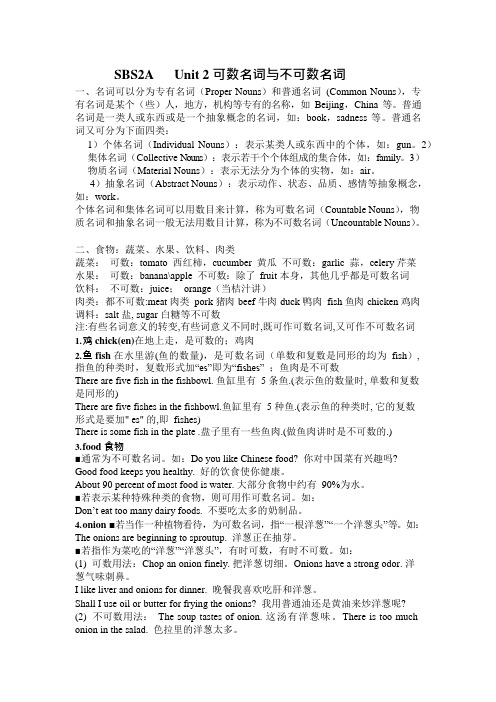
SBS2A Unit 2 可数名词与不可数名词一、名词可以分为专有名词(Proper Nouns)和普通名词(Common Nouns),专有名词是某个(些)人,地方,机构等专有的名称,如Beijing,China 等。
普通名词是一类人或东西或是一个抽象概念的名词,如:book,sadness 等。
普通名词又可分为下面四类:1)个体名词(Individual Nouns):表示某类人或东西中的个体,如:gun。
2)集体名词(Collective Nouns):表示若干个个体组成的集合体,如:family。
3)物质名词(Material Nouns):表示无法分为个体的实物,如:air。
4)抽象名词(Abstract Nouns):表示动作、状态、品质、感情等抽象概念,如:work。
个体名词和集体名词可以用数目来计算,称为可数名词(Countable Nouns),物质名词和抽象名词一般无法用数目计算,称为不可数名词(Uncountable Nouns)。
二、食物:蔬菜、水果、饮料、肉类蔬菜:可数:tomato 西红柿,cucumber 黄瓜不可数:garlic 蒜,celery 芹菜水果:可数:banana\apple 不可数:除了fruit 本身,其他几乎都是可数名词饮料:不可数:juice;orange(当桔汁讲)肉类:都不可数:meat 肉类pork 猪肉beef 牛肉duck 鸭肉fish 鱼肉chicken 鸡肉调料:salt 盐, sugar 白糖等不可数注:有些名词意义的转变,有些词意义不同时,既可作可数名词,又可作不可数名词1.鸡chick(en)在地上走,是可数的;鸡肉2.鱼fish 在水里游(鱼的数量),是可数名词(单数和复数是同形的均为fish),指鱼的种类时,复数形式加“es”即为“fishes”;鱼肉是不可数There are five fish in the fishbowl. 鱼缸里有5 条鱼.(表示鱼的数量时, 单数和复数是同形的)There are five fishes in the fishbowl.鱼缸里有5 种鱼.(表示鱼的种类时, 它的复数形式是要加" es" 的,即fishes)There is some fish in the plate .盘子里有一些鱼肉.(做鱼肉讲时是不可数的.)3.f ood 食物■通常为不可数名词。
- 1、下载文档前请自行甄别文档内容的完整性,平台不提供额外的编辑、内容补充、找答案等附加服务。
- 2、"仅部分预览"的文档,不可在线预览部分如存在完整性等问题,可反馈申请退款(可完整预览的文档不适用该条件!)。
- 3、如文档侵犯您的权益,请联系客服反馈,我们会尽快为您处理(人工客服工作时间:9:00-18:30)。
寒假专题二:名词数的表达二. 重点、难点:语法详解:不可数名词及可数名词数的表达三. 具体内容:重难点解析:英语表达数目和数量的特别方法不可数名词没有表示复数的“—s”标志,因此前面不可有数目字,只可以有数量词。
例如我们可以说①,不可以说②:①There is not much furniture(家具)in the office.②There are not many furnitures in the office.这是不是说不可数名词就不可数呢?不然。
相反的,不可数名词也是可数的,主要方法是借助单位词(unit word),如:a piece of,a cup of,a drop of,a lump of,a handful of,a flash of,a blade of,a head of,a bar of,an ear of等。
如果数目超过“一”,就以确实数目取代“一”。
例如:two pieces of,three cups of 和five lumps of 等。
现在试试把上述这类单位词和适当的不可数名词连用。
①Mr. Li has just bought a piece of new furniture.②Give me a cup of cold water,please.③Please put two lumps of sugar in my coffee.④The boy picked up two handfuls of sand from the beach.⑤We saw a flash of lightning in the sky.⑥The gardener pulled out blades of wild grass from the garden.⑦She gave bars of chocolate to the visiting children.有些名词如scissors,trousers,spectacles,tongs,pliers 等,都以复数形式出现,如:⑧The scissors are lying on the table.⑨The spectacles fit me nicely.如果要给这些名词表示单数“一”的意思,就要借重单位词了。
例如:⑩Mary has just bought a pair of scissors.11 The mechanic repaired the machine with a set of pliers.现代英语注重简洁,合成形容词便应运而生,其中有一种是用来表示数目的,方法是:“数目+名词”,如:a five—year plan,a ten—dollar note,a two—hour meeting,a three —day conference等。
必须注意的是,这种合成形容词中的名词,只能以单数形式出现。
如果用复数,就错了,如:a five—years plan,a ten—dollars note,a two—hours meeting,a three—days conference.这类错误,虽然频率不是很高,但也是要留意才好。
如果没有把握,不妨用完整的表达方式,如:a five—year plan→a plan of five yearsa ten—dollar note→a note of ten dollarsa three—day conference→a conference of three days 等。
【典型例题】可数名词和不可数名词一、名词:名词是所有事物的名称,包括人、物及抽象概念。
名词分为普通名词和专有名词两大类。
名词在句子中作主语,宾语或表语等。
1. 普通名词普通名词是某类人、事件、物体和抽象概念的名称。
根据所指代物体的特征,普通名词又可分为以下四类:A. 个体名词:表示人或物体中可以数清的个体。
如:student(学生)、pen(钢笔)、bird(鸟)等。
B. 集体名词:(即集合名词)表示由个体组成的集合体。
如:people(人民)、police (警察)、family(家庭)等C. 物质名词:表示构成物体物质的不可数名词,或表示无法分为个体的物质的名词。
如:water(水)、air(空气)、wood(木头)等。
D. 抽象名词:表示动作、状态、品质、情感等非具体化的抽象概念。
如:work(工作)、peace(和平)、love(爱)等。
2. 专有名词:专有名词是某些人、事物、机构、组织等特有的名称。
主要包括:人名、地名、国名、党派名称等。
如:Churchill(丘吉尔)、Tokyo(东京)、China(中国)等。
二、可数名词和不可数名词。
1)可数名词:一般来说个体名词和集体名词可以用数目来计算,称为可数名词。
可数名词有单数和复数两种形式。
例如:a book, two books, a student, three students, a family, many families。
名词单数变复数变化如下:1. 词尾直接加s如:cat—cats bag—bags day—days2. 以s, sh, ch, x 结尾的词加es 如:class—classes match—matches box—boxes dish —dishes3. 以辅音加y结尾的词变y为i, 加es. 元音加y结尾的词直接加s,如:party—parties city—cities story—storiesboy—boys monkey—monkeys key—keys 等。
4. 以f或fe结尾的词, 变f或fe为v, 加es,如:wife —wives half—halves注意特殊情况直接加“s”,要逐个记chiefs, handkerchiefs, roofs.5. 以辅音加o 结尾的词常加es, 如:tomatoes, potatoes, heroes.元音加o结尾直接加s. 如:radios, zoos, pianos.特殊情况:photos6. 名词单数变复数特殊变化也要逐个记。
如:man—men, woman—women, tooth—teeth,goose—geese, foot—feet, child—children, mouse—mice2)不可数名词不可数名词不能用数字计算。
包括物质名词(air, water等)及抽象名词(advice, hate)等。
所以它通常只有单数形式。
如:English, air, water, cotton, work…不可数名词表示数量时,可以用量词来表达(量词有复数形式)其结构是数词+量词+of+名词。
如:a bottle of water, two cups of tea, three pieces of paper注意事项:1. 不可数名词没有复数变化,不能用a,an,但可用the,或不用冠词,如:Bread is the usualbreakfast.2. 虽然不可数名词没有复数变化,但量词超过一时要加复数。
如:three cups of coffee, five bottles of water3. 有量词修饰时注意名词是否可数,不可数时用单数,可数时用复数,如:ten bags of rice —ten baskets of eggs1. 英语句式要在主语、谓语上保持数的一致。
1)These are new__________.A. bookB. a bookC. booksD. /注:名词的复数形式及其发音。
可数名词的复数形式一般在单数形式后+s , 清辅音后的s读/s/, 浊辅音或元音后的s 读/z/.map—maps /s/friend—friends /z/radio—radios /z/在s,x, ch, sh结尾的词后+es , 此es读/iz/fox——foxesbus—busesbox—boxeswish—wisheswatch—watchesclass—classes在以辅音字母+y的词后,把y变成i ,再加es, 此es读/iz/;元音字母+y结尾的词则+s,读/z/.story——storiescity——citiesboy——boysplay——playsday——days以f,fe结尾的词,把f,fe变成v, 再加es, es读/z/。
wife—wivesleaf——leaveswolf—wolvesbeef—beeves以o结尾的词,多数+es, 少数+s, 都读/z/tomato——tomatoeshero——heroespotato——potatoesNegro——Negroesradio——radiospiano——pianoszoo———zoosphoto——photos词形不变deer sheep Chinese Japanese有的复数在词形上要作相应变化:a German Germansan American Americansan Egyptian Egyptiansan Arab Arabsa Russian Russiansan Italian Italiansa Frenchman Frenchmenan Englishman Englishmen特殊变化man menwoman womenfisherman fishermenfoot feettooth teethgoose geesechild childrenmouse miceox oxenpoliceman policemen2. 抽象名词的用法:英语中有一部分名词用来表示抽象概念,这些抽象名词前不加“a ”,后不加“s”.1)His father went to his doctor for _______ about his heart trouble.A. an adviceB. some adviceC. adviceD. the advices又如:progress informationfun newsweather workhousework homeworkadvice为不可数名词,没有复数形式。
可以说some advice, 但不能说an advice表示一条建议:a piece of advice一条信息:a piece of information例1 Swimming is _______ in summer.A. a great funB. great funC. great funsD. great a funfun是抽象名词(不可数名词),前面不能用冠词,也没有复数形式。
